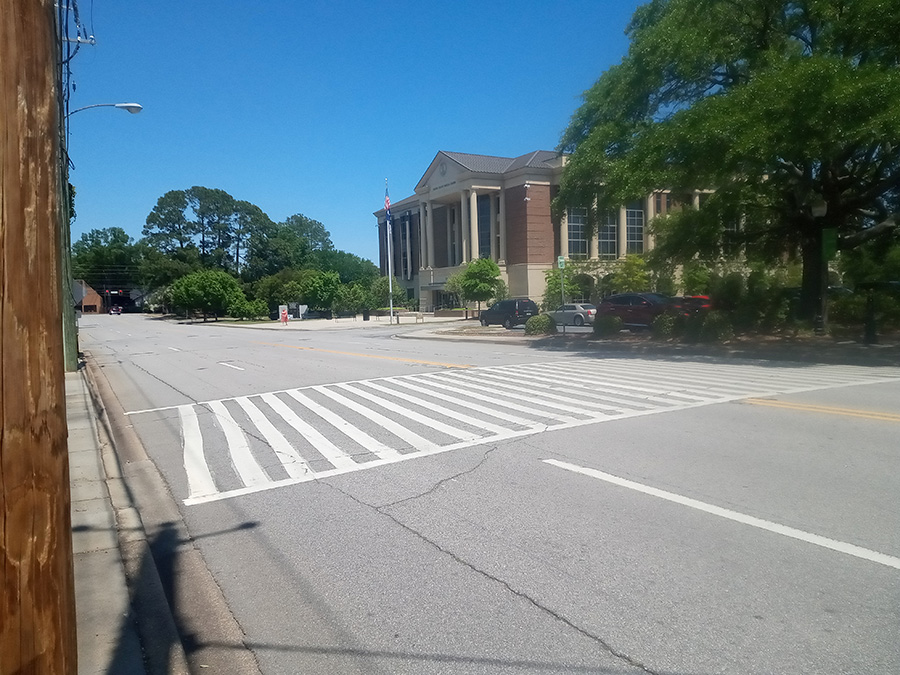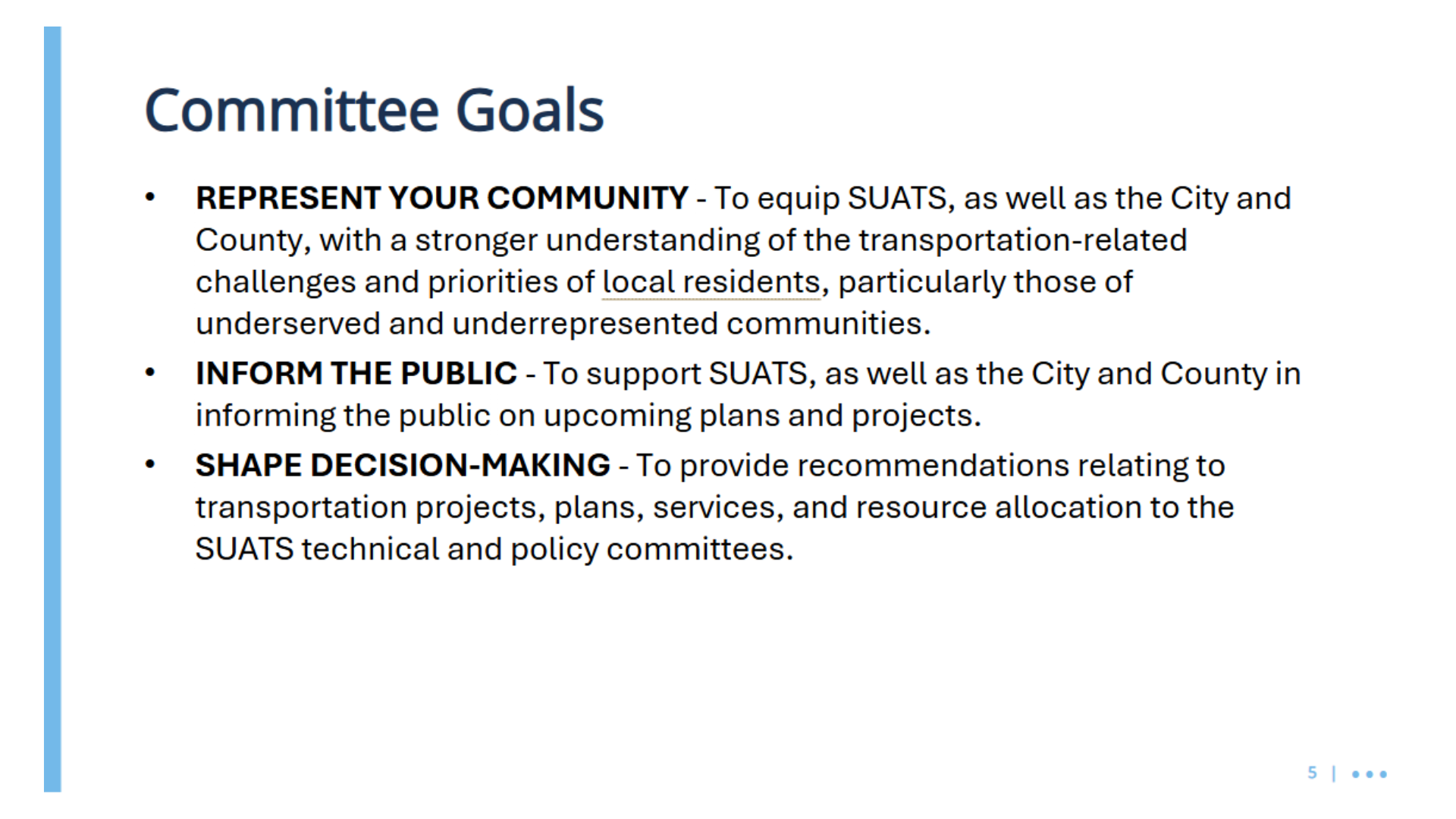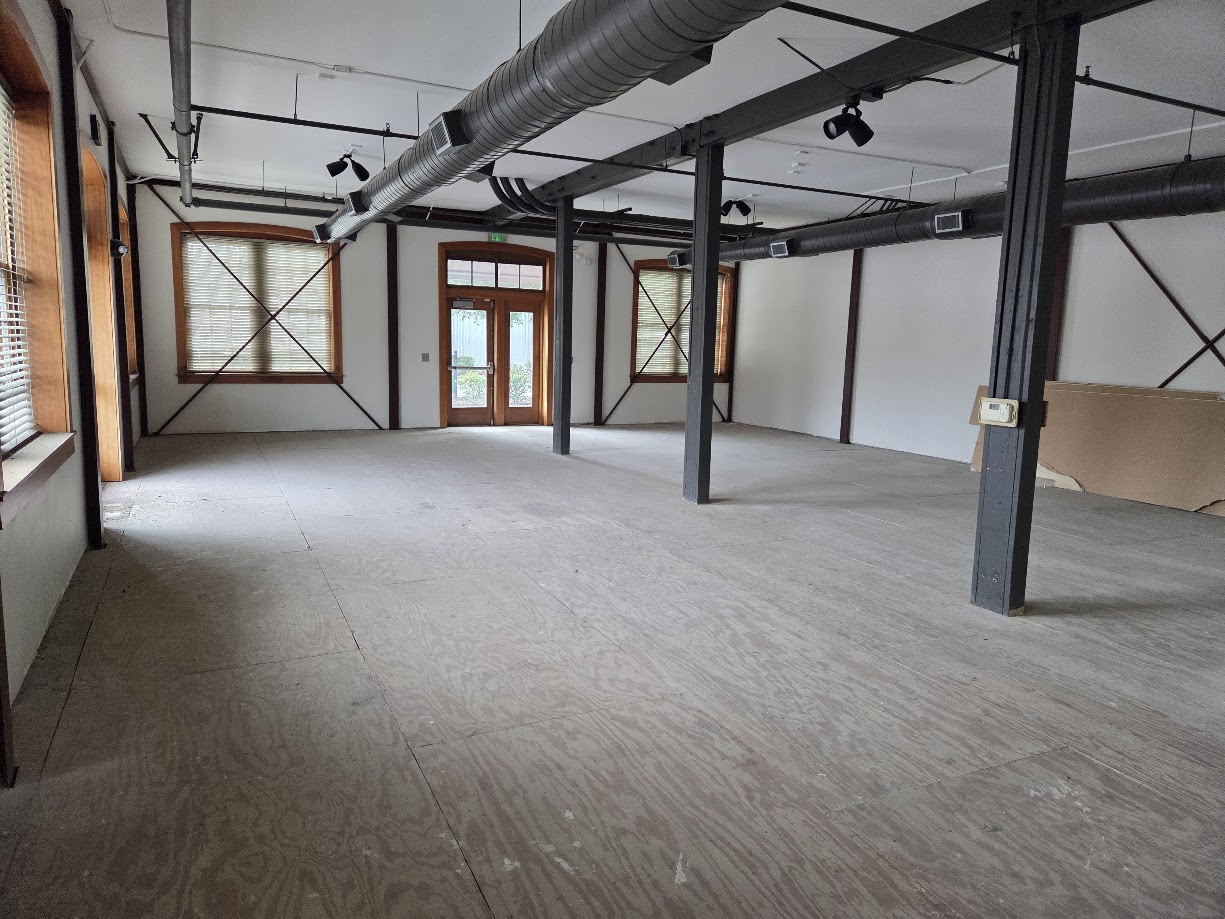Header image credit: mogollon_1, CC BY 2.0, via Wikimedia Commons
A summary of ACEEE’s work with Sumter, South Carolina, through the U.S. Department of Transportation Thriving Communities Technical Assistance Program.
View additional case studies:
Lansing, Michigan | Lima, Ohio | St. Louis County, Missouri
Learn more about ACEEE as Capacity Builder for U.S. Department of Transportation Thriving Communities Program

Above: A view of Sumter County Judicial Center from Harvin Street. Funding generated through a 1% sales tax was approved by voters in November 2024 to, among other projects, redesign this street to improve safety and increase on-street parking. Photo by Christi Nakajima, ACEEE.
About the Thriving Communities Program
The Thriving Communities Program (TCP), a U.S. Department of Transportation technical assistance initiative, is designed to support under-resourced communities in overcoming barriers to planning, funding, and implementing projects and initiatives that will expand affordable transportation options, reduce pollution, improve public health, support job creation, and achieve other community goals. Communities were selected to participate through a competitive application process. ACEEE was selected as part of a capacity builder team to provide technical assistance and worked closely with four communities across 2023–2025.
An overview of Sumter
The Sumter Area Transportation Study (SUATS), the metropolitan planning organization (MPO) for the Sumter region, applied to participate in TCP with the intent of expanding public engagement efforts, securing more funding for public transit, and implementing best practices around resilience planning. The SUATS region represents a portion of Sumter County which also encompasses the City of Sumter. Sumter faces several challenges related to transportation safety and access; one of every nine households in the city does not have access to a car, and Sumter County had almost double the national average of vehicle crash fatalities per 100,000 people over the past 10 years.
SUATS and local partners are working to address these issues by implementing traffic calming measures, constructing bicycle and pedestrian infrastructure, and exploring strategies to increase funding for public transit. However, despite significant effort to solicit public input on projects, in most cases only a handful of residents attend public meetings and provide feedback. Additionally, a lack of local match funding means that federal dollars are often left on the table, leaving Santee-Wateree Regional Transportation Authority (SWRTA), the local public transit agency, unable to expand its service or introduce new routes.
TCP initiatives
Throughout the needs assessment and early stages of TCP, SUATS noted an interest in engaging a broader segment of the community in transportation planning and projects, unlocking a new potential revenue stream for SWRTA, and developing a resilience chapter for the Long Range Transportation Plan to address flooding and other environmental challenges. ACEEE developed customized technical assistance materials and engaged in biweekly coordination calls with the Sumter TCP team over the 20-month program to support local leaders in building new capacity in these areas.
Key takeaways and insights:
|
Creating a new resident advisory committee
In response to the need for more robust public engagement processes, ACEEE guided SUATS and City of Sumter staff in developing a list of community-based organizations (CBOs) in Sumter. We supported their outreach to contacts at these CBOs, inviting them to participate in a temporary steering committee that convened with the goals of providing input on upcoming transportation projects, advising on a long-term strategy for comprehensive public engagement, and pulling other CBOs into this effort.
Over the course of seven meetings, committee members offered their thoughts on transportation-related challenges that they wanted to see addressed, asked questions about upcoming projects, and provided ideas and feedback on proposals around future public engagement strategies. From a faith-based organization and a local charter school to a community health center and a senior services organization, the CBOs that participated in these steering committee meetings represented a variety of different perspectives from across Sumter.
After the first few meetings, SUATS and the City of Sumter developed an issue tracker in the form of a spreadsheet, which contained the problems raised by the committee, the identified solution (if any), the status of solution implementation, and next steps. One of the issues raised was the lack of lighting at a busy intersection. This created a safety risk for residents in a high-growth area that had recently been reconfigured by a major SUATS project. Before the final committee meeting, city teams worked with Duke Energy to install two overhead lights at the intersection. Committee members appreciated the responsiveness of government staff, as well as the opportunity to connect with other CBOs in the region.
Based on feedback from the committee, ACEEE and local government partners decided to establish a permanent resident advisory committee that would provide the resident perspective when advising SUATS’s policy committee, which makes decisions about project planning and funding. SUATS’s bylaws were amended in early 2025 to create this committee, and the first meeting will take place after the policy committee appoints members to the resident advisory committee.

Above: Screenshot outlining the draft goals of the Sumter resident advisory committee shared during a meeting facilitated by ACEEE and local government partners in early 2025. Image credit: ACEEE
Supporting resilience planning and project tracking in the Long Range Transportation Plan
Due to the natural hydrology of the area, flooding is a significant challenge for the Sumter region. However, neither the City of Sumter nor SUATS have a dedicated environmental resilience plan as part of a larger plan or as a standalone product. SUATS has identified projects that will help mitigate flooding from heavy rainfall events but has not yet included those projects in the Long Range Transportation Plan (LRTP), which is intended to guide transportation investments over the next 25 years. Further, the organization does not yet have a mechanism to rank or prioritize these projects. SUATS is drafting a resilience chapter to include in the LRTP via amendment but needed support on key elements to include and best practices for developing an effective plan.
ACEEE conducted a literature review of other MPOs’ resilience-related plans and goals. We used this to develop an outline, annotated with references to these plans, best practices, and key considerations, that will provide the foundation for the full resilience chapter that will be drafted during the summer and fall of 2025.
Additionally, the LRTP contains a list of action items linking to policy goals related to various transportation categories. SUATS sought to develop a report card that would display these action items and their current status in a standalone, easy-to-digest format. The goal of this report card is to improve accountability and facilitate a stronger understanding among stakeholders of where each action item stands. ACEEE provided feedback on a draft report card developed by SUATS, including input on terminology, categorization, identifying a lead agency, and how to make certain action items more measurable. We also created a designed template for the report card that can easily be updated and printed for distribution to stakeholders.
Leveraging existing assets to generate revenue for public transit
Currently, local funding commitments for public transit in Sumter are not sufficient to leverage the maximum amount of federal match dollars available to SWRTA. As part of a multi-pronged effort to add additional resources and enhance area transit services, SUATS and SWRTA developed a plan to tap into a new source of local funds with support from ACEEE. SWRTA’s James Clyburn Intermodal Transportation Center contains several vacant spaces that were built to be leased to third parties for compatible commercial uses but were never finished. SWRTA and other local partners are working to prepare the available spaces in the Clyburn Center to be leased so the lease funds can generate revenue for future transit service improvements and expansion.

Above: the James Clyburn Intermodal Transportation Center, which houses the administrative offices for SWRTA in addition to shell spaces like the one above. Image credit: SUATS
Funding will be needed to complete renovations to make the spaces marketable. Complicating these efforts was a history of confusion regarding the Federal Transit Administration (FTA)’s role with regard to eligible use of the building, as development of the Clyburn Center was supported by federal funds. With limited records of that original agreement and guidance, SUATS and SWRTA requested support from ACEEE to understand current FTA guidance and identify funding sources for renovations. We confirmed that under joint development guidelines, SWRTA should be able to renovate and lease spaces within the Intermodal Transportation Center. We also developed a detailed list of potential federal and nonprofit funding sources for local partners to consider. Work to plan and implement renovations is currently underway.
Summary of impact
After participating in the Thriving Communities Program, SUATS and local partners are better equipped to tackle safety, access, and flooding challenges with updated plans and new funding sources. With ACEEE’s support, SUATS was left with a new formal structure for consistently engaging with community leaders on local priorities and upcoming projects. Additionally, best practices in resilience planning and considerations for project prioritization will allow SUATS and partners to leverage state and federal dollars to fund projects that will mitigate the impacts caused by heavy rainfall events. Finally, information on potential funding sources for renovations to the James Clyburn Intermodal Transportation Center will enable SWRTA to take the next step in obtaining a new source of funding for improved transit service.

